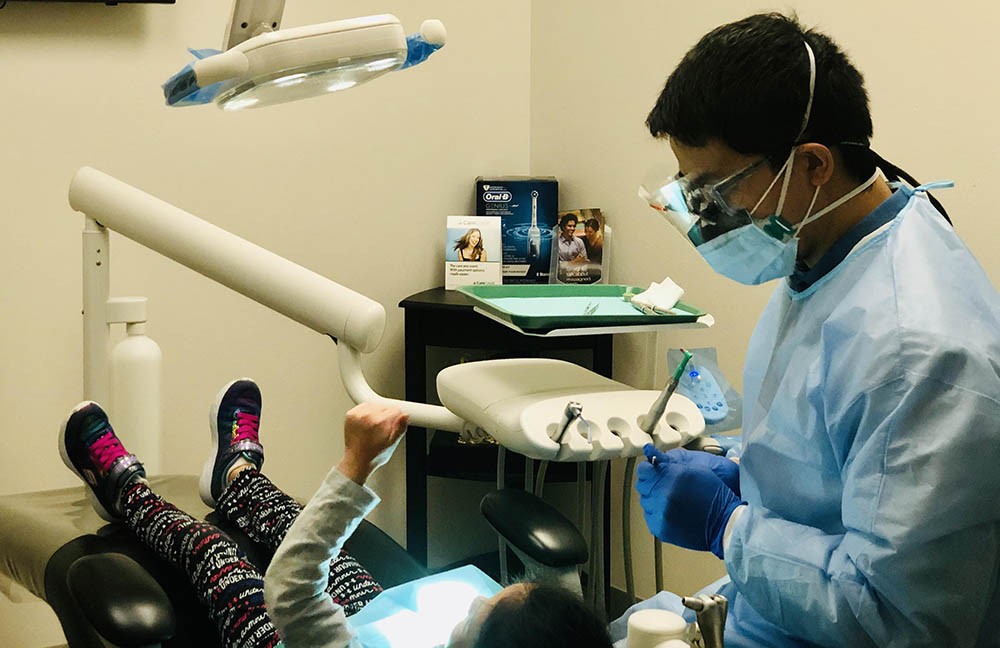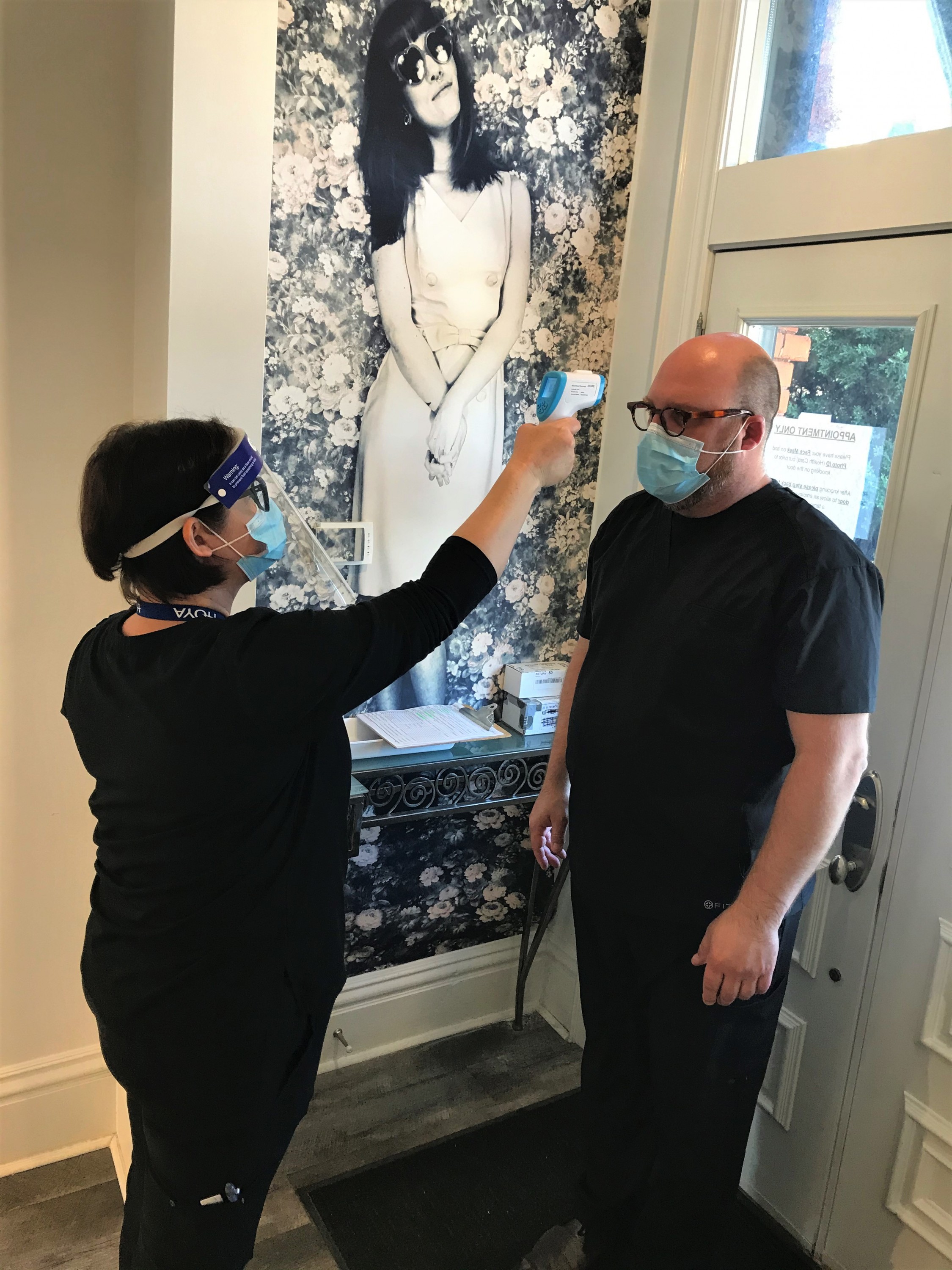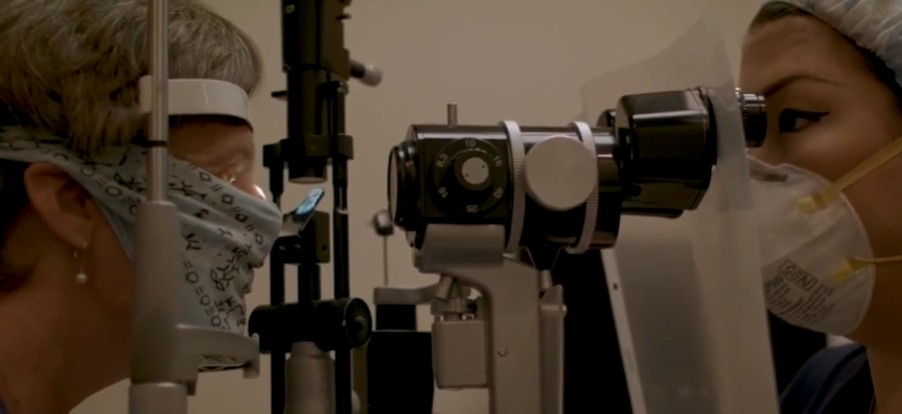
‘It’s not going to be doors open, back to normal’ for optometrists, dentists and massage therapists
The definition of a high-risk job is rapidly changing amid the ongoing COVID-19 global pandemic.
Such work exposes employees to a higher level of danger; many would think of firefighters, police or paramedics. However, due to the risk of infection many vocations not previously associated with such challenges are now more dangerous because of the chances of exposure to the novel coronavirus.
Optometry, dentistry, massage therapy and physiotherapy practices are hands on jobs now forced to take more precautions with personal protective equipment (PPE) and during all interactions with those who come in close contact with practitioners.

Dr. Sheldon Salaba's optometry practices in Hamilton will be screening for temperature upon arrival
Two weeks ago, the provincial government announced that health care practices may start seeing patients for routine check-ups. Practices such as Mark Yan’s had not been able to open due to emergency measures in place by the government.
He owns his own therapeutic massage clinic in Brampton, where he’s worked from his home for 34 years. Massage therapists were left out under Premier Doug Ford’s emergency orders in place since March, but with the latest announcement they are now allowed to see those suffering severe amounts of pain.
To be able to operate Yan must follow strict guidelines from the College of Massage Therapy of Ontario, which includes a rigorous cleaning process and replacing anything upholstered in the practice.
“It’s well thought out,” Yan said of the guidelines.
He has been instructed to wear gloves and a mask while giving a massage and clients also have to wear masks, which he says does not take away from the treatment.
The college has also asked for massage therapists to keep a detailed log with the names, addresses and contact information of everyone who comes into their practice, so contact tracing can be done if any future risk of infection arises.
“That’s what is really going to save us, when you know everyone you’ve been in contact with and you can tell people. It will really stop the spread,” Yan said.
Many other healthcare practices are taking similar approaches with more than usual PPE and contacting tracing techniques. Dr. Patrick Quaid of the College of Optometrists of Ontario said that sanitizing every tool in their offices will reduce the number of appointments optometrists can schedule in a day.
“It’s not that you can’t see that routine patient but just given that each slot will be more essential,” he said.
Optometrists, similar to some dentists, were allowed to work during the peak of the pandemic but only in emergency situations. No routine procedures for either profession was allowed.
Dr. Quaid thinks that now, with the new guidelines, is a good time to open up practices again, because the longer they remain closed it increases the risk that some patients with serious problems will only see them get worse if they don’t get attention as soon as possible.
“We don’t want that patient abandoned or worse, we don’t want that patient to go to emergency because that’s the last place they should be going during a pandemic,” he said, referring to the need to keep hospital capacity free for other needs.
Optometry practices are much different than they were before the pandemic and Quaid wants patients to know, “it’s not going to be doors open, back to normal.”
Dr. Sheldon Salaba said that most optometrists are “super excited to be back at work.”
At his practices in Hamilton, patients are asked to stay in the car until the doctor is ready to see them, once inside the patient will be handed a mask, if they do not have one, and hand sanitizer will be applied by an employee using proper protective equipment.
The employee will also ask screening questions and take the temperature of the patient.
On the floor there are many signs encouraging physical distancing and pointing out where patients can stand. Inside the examination room, doctors will be wearing a grade two surgical mask and breath shields will be on the machines.

Once the appointment has concluded, staff will spend 10-15 minutes cleaning the room and all the equipment and tools before the next patient arrives, while the doctor will jump to the next room for the next appointment.
The extra time spent cleaning in between patients has caused most optometrists to reduce appointments from 40-60 per cent.
Dr. Salaba is also the President of the Ontario Association of Optometrists giving him a unique look at many practices across the province.
“I’ve heard of some of my colleagues, not in my own personal practice, having difficulty recalling staff back,” he said.
He believes part of the issue is that staff that have school-age children may not be able to return to work due to classes not resuming or child care places not opening up yet. He is concerned about the possibility of bankruptcy for some practitioners.
“There are places that are going to lose their local optometrists, without a doubt,” he said.
Because OHIP does not cover many of the costs associated with optometry, and some patients do not have adequate insurance, this has led to financial considerations for practices. For those who have lost their income or had it dramatically reduced, it can be difficult to pay optometrist costs, making it challenging for some practices to keep operating.
Similar physical distancing measures and other protocols are being taken at dental offices. Like other healthcare practices, dentists look toward the guidelines set by their governing body, the Royal College of Dental Surgeons of Ontario, while the College of Dental Hygienists of Ontario is the professional body that hygienists work under. Both have set out rules for reopening that comply with provincial safety standards during the pandemic.
Before arriving, a screening process through a questionnaire will be administered. If the office is big enough there will be different entry and exit points with proper signage. Face coverings or masks will be worn until inside the examination room where the hygienist will be wearing an N95 mask, an isolation gown, gloves and some form of eye protection.
Similar guidelines are in place for dentists.
Dealing directly with people who have their mouths open, it is important for hygienists and dentists to wear the proper equipment to keep themselves and their patients safe. There are limits to the number of people patients can bring with them to a practice, so younger children may not be allowed while a parent has an appointment. Routine temperature checks will be conducted and alcohol-based soap has to be used for hand washing.
However, because of the obvious risks, some staff and dental practices may not return to business as usual, as it is up to them as individuals to decide if they want to reopen under the new allowances.
Email: [email protected]
Twitter: @taasha__15
COVID-19 is impacting all Canadians. At a time when vital public information is needed by everyone, The Pointer has taken down our paywall on all stories relating to the pandemic to ensure every resident of Brampton and Mississauga has access to the facts. For those who are able, we encourage you to consider a subscription. This will help us report on important public interest issues the community needs to know about now more than ever. You can register for a 30-day free trial HERE. Thereafter, The Pointer will charge $10 a month and you can cancel any time right on the website. Thank you.
Submit a correction about this story


